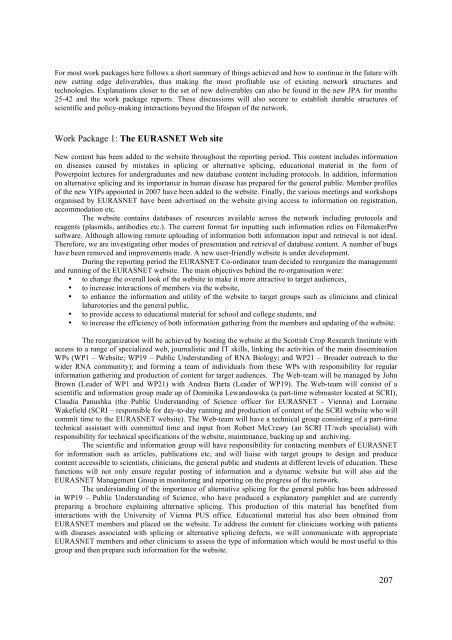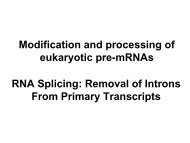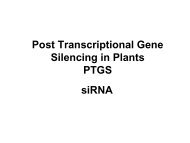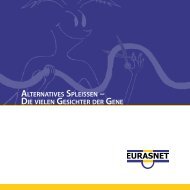Create successful ePaper yourself
Turn your PDF publications into a flip-book with our unique Google optimized e-Paper software.
For most work packages here follows a short summary of things achieved and how to continue in the future withnew cutting edge deliverables, thus making the most profitable use of existing network structures andtechnologies. Explanations closer to the set of new deliverables can also be found in the new JPA for months25-42 and the work package reports. These discussions will also secure to establish durable structures ofscientific and policy-making interactions beyond the lifespan of the network.Work Package 1: The <strong>EURASNET</strong> Web siteNew content has been added to the website throughout the reporting period. This content includes informationon diseases caused by mistakes in splicing or alternative splicing, educational material in the form ofPowerpoint lectures for undergraduates and new database content including protocols. In addition, informationon alternative splicing and its importance in human disease has prepared for the general public. Member pro<strong>file</strong>sof the new YIPs appointed in 2007 have been added to the website. Finally, the various meetings and workshopsorganised by <strong>EURASNET</strong> have been advertised on the website giving access to information on registration,accommodation etc.The website contains databases of resources available across the network including protocols andreagents (plasmids, antibodies etc.). The current format for inputting such information relies on FilemakerProsoftware. Although allowing remote uploading of information both information input and retrieval is not ideal.Therefore, we are investigating other modes of presentation and retrieval of database content. A number of bugshave been removed and improvements made. A new user-friendly website is under development.During the reporting period the <strong>EURASNET</strong> Co-ordinator team decided to reorganize the managementand running of the <strong>EURASNET</strong> website. The main objectives behind the re-organisation were:• to change the overall look of the website to make it more attractive to target audiences,• to increase interactions of members via the website,• to enhance the information and utility of the website to target groups such as clinicians and clinicallabarotories and the general public,• to provide access to educational material for school and college students, and• to increase the efficiency of both information gathering from the members and updating of the website.The reorganization will be achieved by hosting the website at the Scottish Crop Research Institute withaccess to a range of specialized web, journalistic and IT skills, linking the activities of the main disseminationWPs (WP1 – Website; WP19 – Public Understanding of RNA Biology; and WP21 – Broader outreach to thewider RNA community); and forming a team of individuals from these WPs with responsibility for regularinformation gathering and production of content for target audiences. The Web-team will be managed by JohnBrown (Leader of WP1 and WP21) with Andrea Barta (Leader of WP19). The Web-team will consist of ascientific and information group made up of Dominika Lewandowska (a part-time webmaster located at SCRI),Claudia Panushka (the Public Understanding of Science officer for <strong>EURASNET</strong> - Vienna) and LorraineWakefield (SCRI – responsible for day-to-day running and production of content of the SCRI website who willcommit time to the <strong>EURASNET</strong> website). The Web-team will have a technical group consisting of a part-timetechnical assistant with committed time and input from Robert McCreary (an SCRI IT/web specialist) withresponsibility for technical specifications of the website, maintenance, backing up and archiving.The scientific and information group will have responsibility for contacting members of <strong>EURASNET</strong>for information such as articles, publications etc, and will liaise with target groups to design and producecontent accessible to scientists, clinicians, the general public and students at different levels of education. Thesefunctions will not only ensure regular posting of information and a dynamic website but will also aid the<strong>EURASNET</strong> Management Group in monitoring and reporting on the progress of the network.The understanding of the importance of alternative splicing for the general public has been addressedin WP19 – Public Understanding of Science, who have produced a explanatory pamphlet and are currentlypreparing a brochure explaining alternative splicing. This production of this material has benefited frominteractions with the University of Vienna PUS office. Educational material has also been obtained from<strong>EURASNET</strong> members and placed on the website. To address the content for clinicians working with patientswith diseases associated with splicing or alternative splicing defects, we will communicate with appropriate<strong>EURASNET</strong> members and other clinicians to assess the type of information which would be most useful to thisgroup and then prepare such information for the website.207







